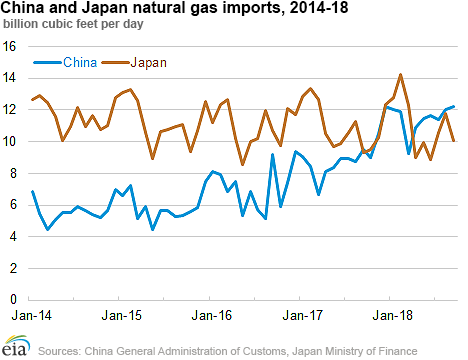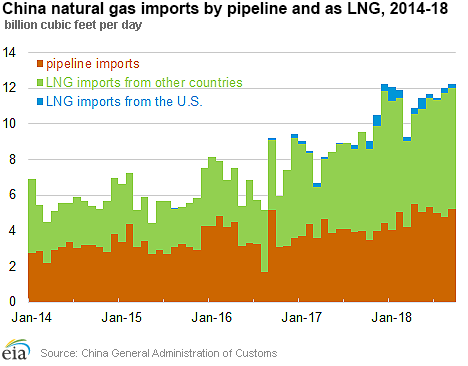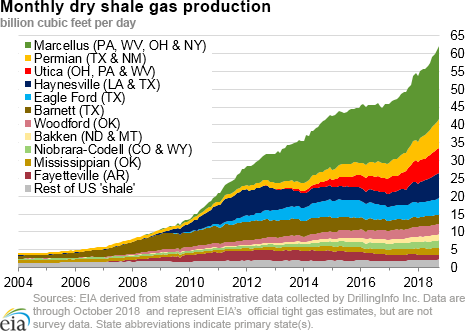In the News:
China becomes world’s largest natural gas importer, overtaking Japan
China’s combined imports of natural gas by pipeline and in the form of liquefied natural gas (LNG) have become the world’s largest consistently for the past six months, overtaking Japan, and exceeding 12 billion cubic feet per day (Bcf/d) in September and October, according to data from China’s Administration of Customs. In the first nine months of this year, China’s total natural gas imports averaged 11.4 Bcf/d, a 2.9 Bcf/d (34%) increase over the same period last year, and more than doubled since 2014, when imports averaged 5.6 Bcf/d.
Strong growth in China’s natural gas imports was led by the increase in domestic consumption, stimulated by government policies promoting coal-to-natural gas switching in an effort to reduce air pollution and meet emissions targets. While China’s domestic natural gas production, which provides more than one half of its total supply, has also grown, it was outpaced by the growth in imports. Between 2014 and 2017, domestic production in China increased by a net of 1.4 Bcf/d, according to BP’s Statistical Review of World Energy, while combined pipeline and LNG imports have increased by 3.4 Bcf/d during the same period.
The growth in China’s natural gas imports was led primarily by the growth in LNG imports. In 2017, China became the world’s second largest LNG importer, with LNG imports growing steadily every year since 2006—when China began importing LNG—except 2015. In the first nine months of 2018, LNG imports averaged 6.5 Bcf/d, 1.5 Bcf/d (30%) higher than in 2017, and are poised for further growth as China continues to expand its LNG import capacity. China’s current LNG import capacity stands at 8.6 Bcf/d, and two more terminals (totaling 0.4 Bcf/d) are expected to come online by the end of the year. Once all the terminals currently under construction are completed, China’s LNG import capacity is expected to reach 11.2 Bcf/d by 2021.
Natural gas imports by pipeline have also been increasing in China and averaged 4.9 Bcf/d in the first nine months of 2018, 0.9 Bcf/d (22%) higher than in 2017 (annual average). Over this period, China’s pipeline imports from Turkmenistan accounted for 69% of the total pipeline imports, from Uzbekistan – for 12%, Kazakhstan – 11%, and Myanmar – 7%. Imports from Kazakhstan led the growth in pipeline imports in 2018, averaging 0.6 Bcf/d (compared to 0.1 Bcf/d in 2017), as the new pipeline supply contract, which started in late 2017, continued in 2018. Imports from Uzbekistan and Turkmenistan have also increased, by 0.3 Bcf/d and 0.2 Bcf/d, respectively.
In 2017, about 4% of China’s LNG imports came from the United States, all on a spot basis, as there are currently no LNG supply contracts between the United States and China. In the first nine months of 2018, U.S. LNG accounted for 5% of China’s total LNG imports, increasing to 11% of the total in January and May. In 2018, China was the fourth largest destination for U.S. LNG cargoes, with exports averaging 0.3 Bcf/d from January through September. Since China imposed 10% tariff on U.S. LNG imports on September 24, only two LNG shipments from the United States went to China, according to Bloomberg’s shipping data, compared to a total of 13 U.S. cargoes that went to China in October and November of 2017.
Overview:
(For the Week Ending Wednesday, December 5, 2018)
- Natural gas spot prices rose at most locations this report week (Wednesday, November 28 to Wednesday, December 5). Henry Hub spot prices rose from $4.44 per million British thermal units (MMBtu) last Wednesday to $4.62/MMBtu yesterday.
- At the New York Mercantile Exchange (Nymex), the December 2018 contract expired last Wednesday at $4.715/MMBtu. The January 2019 contract price decreased to $4.469/MMBtu, down 23¢/MMBtu Wednesday to Wednesday.
- Net withdrawals from working gas totaled 63 billion cubic feet (Bcf) for the week ending November 30. Working natural gas stocks are 2,991 Bcf, which is 19% lower than the year-ago level and 20% lower than the five-year (2013–17) average for this week.
- The natural gas plant liquids composite price at Mont Belvieu, Texas, rose by 16¢/MMBtu, averaging $6.67/MMBtu for the week ending December 5. The price of natural gasoline, ethane, butane, and isobutane rose by 5%, 2%, 6%, and 4%, respectively. The price of propane remained flat week over week.
- According to Baker Hughes, for the week ending Tuesday, November 27, the natural gas rig count decreased by 5 to 189. The number of oil-directed rigs rose by 2 to 887. The total rig count decreased by 3, and it now stands at 1,076.
Prices/Supply/Demand:
Prices rise across the country. Cold temperatures across the country during much of the report week (Wednesday, November 28 to Wednesday, December 5) led to spot price increases. Henry Hub spot prices rose 18¢ from $4.44/MMBtu last Wednesday to $4.62/MMBtu yesterday. At the Chicago Citygate, prices increased 7¢ from $4.41/MMBtu last Wednesday to $4.48/MMBtu yesterday.
At the beginning of the report week, cold temperatures combined with supply limitations resulting from October’s explosion on Enbridge’s Westcoast pipeline in Canada—a major supplier of natural gas to the northwestern United States—led to high spot prices west of the Rockies. These prices fell over the week as more capacity on the Westcoast pipeline was restored to service, bringing operational capacity up to about 1.4 Bcf/d out of the 1.7 Bcf/d pre-explosion capacity. Prices at Sumas on the Canada-Washington border fell $9.40 from $17.06/MMBtu last Wednesday to $7.66/MMBtu yesterday.
Prices at PG&E Citygate in Northern California fell 26¢, down from $6.71/MMBtu last Wednesday to $6.45/MMBtu yesterday. However, in Southern California, supply constraints and cold temperatures led to large price swings throughout the week. Prices at SoCal Citygate increased $2.69 from $7.34/MMBtu last Wednesday to $10.03/MMBtu yesterday, with a high of $13.63/MMBtu on Friday.
Northeast prices rise as cold front moves through. At the Algonquin Citygate, which serves Boston-area consumers, prices increased 98¢ from $5.98/MMBtu last Wednesday to $6.96/MMBtu yesterday. Algonquin prices saw an especially large jump from $5.03/MMBtu on Friday to $11.60/MMBtu on Monday as a cold front moved into the Northeast over the weekend. At the Transcontinental Pipeline Zone 6 trading point for New York City, prices increased 46¢ from $4.53/MMBtu last Wednesday to $4.99/MMBtu yesterday, with a high of $6.03/MMBtu on Tuesday.
Tennessee Zone 4 Marcellus spot prices increased 6¢ from $4.27/MMBtu last Wednesday to $4.33/MMBtu yesterday. Prices at Dominion South in southwest Pennsylvania rose 8¢ from $4.21/MMBtu last Wednesday to $4.29/MMBtu yesterday.
Prices at the Waha Hub in West Texas, which is located near Permian Basin production activities, averaged $0.46/MMBtu last Wednesday, $3.98/MMBtu lower than Henry Hub prices. Yesterday, prices at the Waha Hub averaged $2.12/MMBtu, $2.50/MMBtu lower than Henry Hub prices. This increase in Waha prices came amid colder temperatures in the Southwest.
Nymex prices fall. At the Nymex, the December 2018 contract expired last Wednesday at $4.715/MMBtu. In contrast to spot prices, the January 2019 contract decreased to $4.469/MMBtu, down 23¢/MMBtu from last Wednesday to yesterday. The price of the 12-month strip averaging January 2019 through December 2019 futures contracts declined 1¢/MMBtu to $3.249/MMBtu.
Supply remains flat. According to data from PointLogic Energy, the average total supply of natural gas remained the same as in the previous report week, averaging 92.7 Bcf/d. Dry natural gas production remained constant week over week. Average net imports from Canada decreased by 1% from last week.
Demand falls. Total U.S. consumption of natural gas fell by 1% compared with the previous report week, according to data from PointLogic Energy. Natural gas consumed for power generation climbed by 2% week over week. Industrial sector consumption decreased by 1% week over week. In the residential and commercial sectors, consumption declined by 4%. Despite the cold front that moved through the country this week, the previous report week was also cold and actually had more population-weighted heating degree days. Natural gas exports to Mexico decreased 1%.
Updated on December 13, 2018, to report revised exports.
U.S. LNG exports increase week over week. Eight LNG vessels (six from the Sabine Pass liquefaction terminal and two from Cove Point) with a combined LNG-carrying capacity of 27.9 Bcf departed the United States from November 29 to December 5, according to Bloomberg shipping data.
A tanker waiting to load the first LNG produced from the new Corpus Christi liquefaction terminal in Texas has been berthed at the terminal’s jetty since December 5, according to Bloomberg shipping data.
U.S. LNG exports in November set a new record with 32 loaded cargoes (26 from Sabine Pass and 6 from Cove Point), exceeding the previous record set in July with 29 exported cargoes.
Storage:
Working gas stocks in the Lower-48 states ended November below 3,000 Bcf for the first time since 2002. Net withdrawals from storage totaled 63 Bcf for the week ending November 30, compared with the five-year (2013–17) average net withdrawals of 58 Bcf and last year's net withdrawals of 3 Bcf during the same week. Working gas stocks totaled 2,991 Bcf, which is 725 Bcf lower than the five-year average and 704 Bcf lower than last year at this time.
Working gas stocks’ deficit to the five-year average increases and deficit to the bottom of the five-year range increases. In the Lower 48 states, total working gas stocks are 404 Bcf lower than the five-year minimum, and every storage region is currently lower than the bottom of its five-year range. The deficit to the bottom of the range increased in all regions except the Pacific and South Central salt regions. As of this report week, the Midwest region is 58 Bcf (6%) lower than the five-year minimum, and the South Central region―including both salt and nonsalt facilities―is 173 Bcf (16%) lower than the five-year minimum.
The average January 2019 futures contract price is trading at a discount to the average spot price, which provides incentive for storage withdrawals. Price differences between the spot price and the futures price at the Nymex indicate economic incentives for withdrawals from working gas. During the most recent storage week, the average natural gas spot price at the Henry Hub averaged $4.37/MMBtu, and the Nymex futures price of natural gas for delivery in January 2019 averaged $4.46/MMBtu, 9¢/MMBtu higher than the spot price. A year ago, the January contract was 13¢/MMBtu higher than the spot price.
Reported net withdrawals into storage are close to the median of analysts’ expectations. According to The Desk survey of natural gas analysts, estimates of the weekly net change from working natural gas stocks ranged from net withdrawals of 52 Bcf to 70 Bcf, with a median estimate of 61 Bcf. At the 10:30 a.m. release of the Weekly Natural Gas Storage Report, the price of the Nymex futures contract for December delivery at the Henry Hub increased somewhat to $4.47/MMBtu, with 136 trades executed. The price varied in subsequent trading, ranging between $4.45/MMBtu and $4.49/MMBtu.
Temperatures are lower than normal for the storage week. Temperatures in the Lower 48 states averaged 41 degrees Fahrenheit (°F), 1°F lower than normal and 7°F lower than last year at this time. Temperatures equaled those reported for the previous week.
See also:
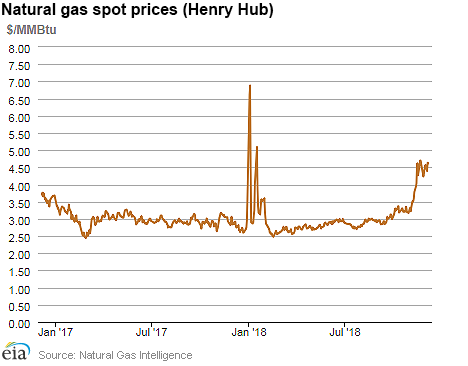
| Spot Prices ($/MMBtu) | Thu, 29-Nov |
Fri, 30-Nov |
Mon, 03-Dec |
Tue, 04-Dec |
Wed, 05-Dec |
|---|---|---|---|---|---|
| Henry Hub |
4.50 |
4.57 |
4.39 |
4.63 |
4.62 |
| New York |
4.47 |
4.36 |
4.74 |
6.03 |
4.99 |
| Chicago |
4.46 |
4.40 |
4.40 |
4.51 |
4.48 |
| Cal. Comp. Avg.* |
6.06 |
6.99 |
7.31 |
7.07 |
6.36 |
| Futures ($/MMBtu) | |||||
| January contract | 4.646 |
4.612 |
4.339 |
4.457 |
4.469 |
| February contract |
4.482 |
4.419 |
4.157 |
4.305 |
4.330 |
| *Avg. of NGI's reported prices for: Malin, PG&E Citygate, and Southern California Border Avg. | |||||
| Sources: Natural Gas Intelligence and CME Group as compiled by Bloomberg, L.P. | |||||
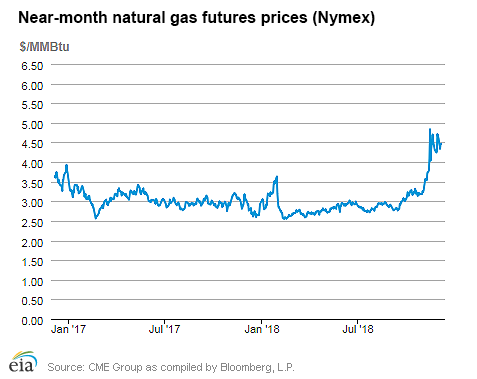
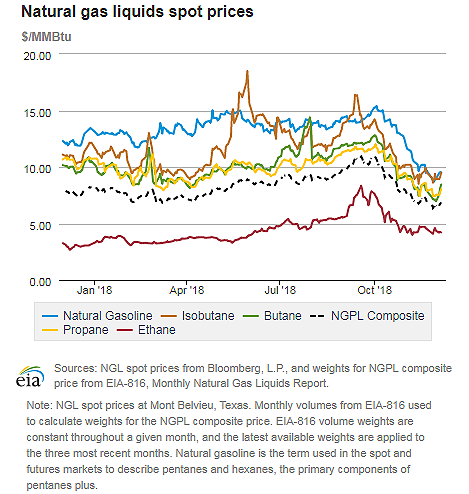
| U.S. natural gas supply - Gas Week: (11/29/18 - 12/5/18) | |||
|---|---|---|---|
Average daily values (Bcf/d): |
|||
this week |
last week |
last year |
|
| Marketed production | 99.1 |
98.8 |
87.5 |
| Dry production | 88.7 |
88.5 |
78.4 |
| Net Canada imports | 3.9 |
4.0 |
5.2 |
| LNG pipeline deliveries | 0.1 |
0.1 |
0.2 |
| Total supply | 92.7 |
92.5 |
83.7 |
|
Source: OPIS PointLogic Energy, an IHS Company | |||
| U.S. natural gas consumption - Gas Week: (11/29/18 - 12/5/18) | |||
|---|---|---|---|
Average daily values (Bcf/d): |
|||
this week |
last week |
last year |
|
| U.S. consumption | 83.1 |
84.2 |
70.6 |
| Power | 23.1 |
22.6 |
22.0 |
| Industrial | 23.7 |
23.9 |
22.6 |
| Residential/commercial | 36.3 |
37.8 |
26.1 |
| Mexico exports | 4.4 |
4.5 |
4.4 |
| Pipeline fuel use/losses | 7.4 |
8.0 |
6.3 |
| LNG pipeline receipts | 4.4 |
4.5 |
3.1 |
| Total demand | 99.3 |
101.1 |
84.4 |
|
Source: OPIS PointLogic Energy, an IHS Company | |||
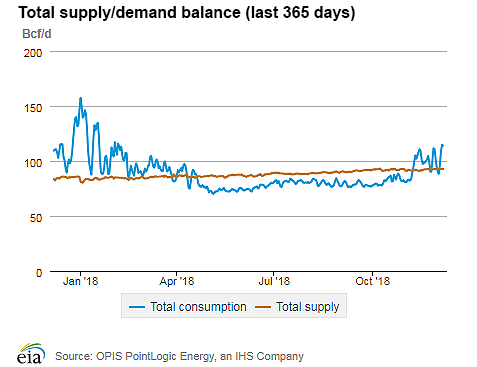
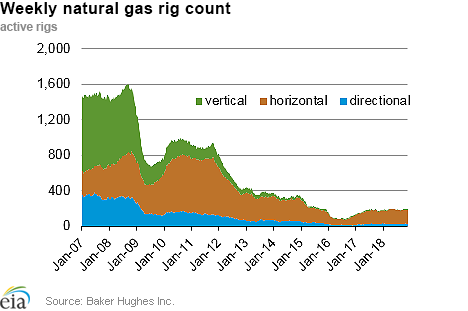
| Rigs | |||
|---|---|---|---|
Tue, November 27, 2018
|
Change from |
||
last week |
last year |
||
| Oil rigs | 887 |
0.2% |
18.4% |
| Natural gas rigs | 189 |
-2.6% |
5.0% |
| Note: Excludes any miscellaneous rigs | |||
| Rig numbers by type | |||
|---|---|---|---|
Tue, November 27, 2018
|
Change from |
||
last week |
last year |
||
| Vertical | 74 |
-3.9% |
12.1% |
| Horizontal | 934 |
0.5% |
17.9% |
| Directional | 68 |
-6.8% |
-4.2% |
| Source: Baker Hughes Inc. | |||
| Working gas in underground storage | ||||
|---|---|---|---|---|
Stocks billion cubic feet (Bcf) |
||||
| Region | 2018-11-30 |
2018-11-23 |
change |
|
| East | 752 |
778 |
-26 |
|
| Midwest | 914 |
938 |
-24 |
|
| Mountain | 168 |
171 |
-3 |
|
| Pacific | 253 |
254 |
-1 |
|
| South Central | 905 |
914 |
-9 |
|
| Total | 2,991 |
3,054 |
-63 |
|
|
Source: Form EIA-912, "Weekly Underground Natural Gas Storage Report" | ||||
| Working gas in underground storage | |||||
|---|---|---|---|---|---|
Historical comparisons |
|||||
Year ago (11/30/17) |
5-year average (2013-2017) |
||||
| Region | Stocks (Bcf) |
% change |
Stocks (Bcf) |
% change |
|
| East | 869 |
-13.5 |
876 |
-14.2 |
|
| Midwest | 1,059 |
-13.7 |
1,046 |
-12.6 |
|
| Mountain | 221 |
-24.0 |
213 |
-21.1 |
|
| Pacific | 313 |
-19.2 |
342 |
-26.0 |
|
| South Central | 1,232 |
-26.5 |
1,239 |
-27.0 |
|
| Total | 3,695 |
-19.1 |
3,716 |
-19.5 |
|
| Source: Form EIA-912, "Weekly Underground Natural Gas Storage Report" | |||||
| Temperature – heating & cooling degree days (week ending Nov 29) | ||||||||
|---|---|---|---|---|---|---|---|---|
HDD deviation from: |
CDD deviation from: |
|||||||
| Region | HDD Current |
normal |
last year |
CDD Current |
normal |
last year |
||
| New England | 210 |
22 |
32 |
0 |
0 |
0 |
||
| Middle Atlantic | 206 |
26 |
37 |
0 |
0 |
0 |
||
| E N Central | 222 |
16 |
59 |
0 |
0 |
0 |
||
| W N Central | 242 |
10 |
95 |
0 |
0 |
0 |
||
| South Atlantic | 161 |
38 |
40 |
8 |
-2 |
-4 |
||
| E S Central | 158 |
31 |
37 |
0 |
-1 |
0 |
||
| W S Central | 84 |
-8 |
27 |
5 |
1 |
1 |
||
| Mountain | 174 |
-25 |
68 |
0 |
0 |
-5 |
||
| Pacific | 80 |
-22 |
30 |
0 |
-1 |
-1 |
||
| United States | 170 |
8 |
47 |
2 |
0 |
-1 |
||
|
Note: HDD = heating degree day; CDD = cooling degree day Source: National Oceanic and Atmospheric Administration | ||||||||
Average temperature (°F)
7-Day Mean ending Nov 29, 2018
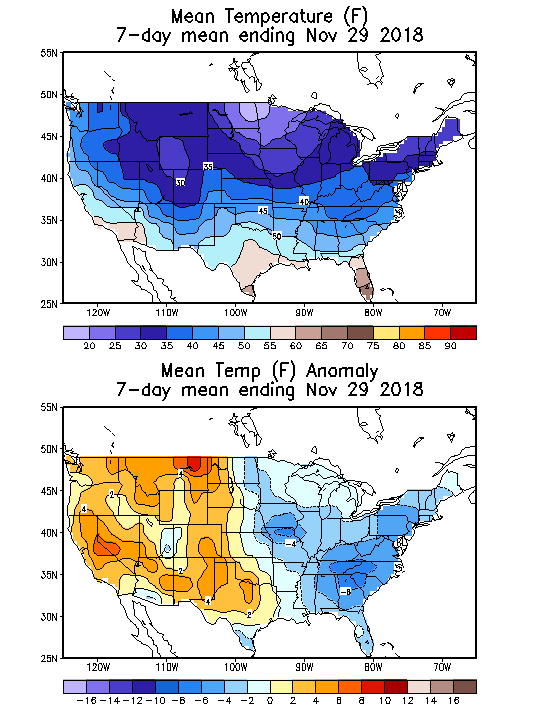
Source: NOAA National Weather Service
Deviation between average and normal (°F)
7-Day Mean ending Nov 29, 2018

Source: NOAA National Weather Service

